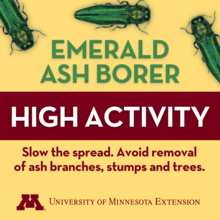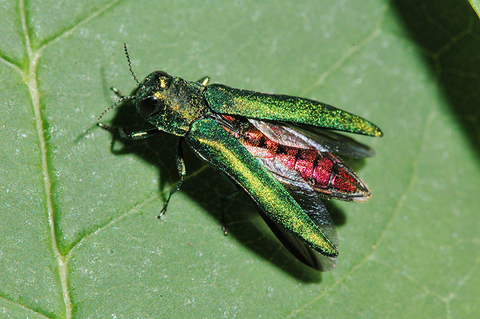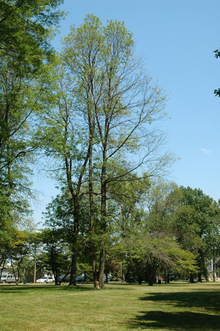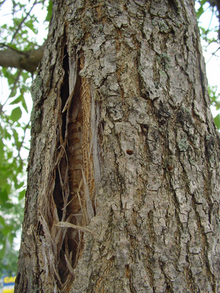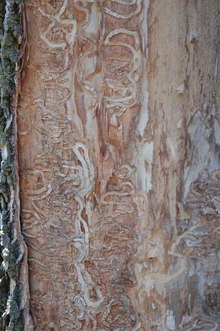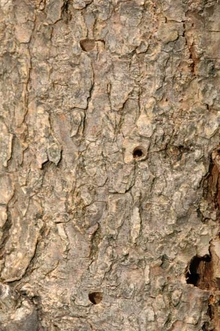Quick facts
- Emerald ash borer (EAB) is a very destructive insect pest that attacks all species of North American ash.
- Ash trees are killed if not protected by insecticides.
- The Minnesota Department of Agriculture has quarantines on ash wood and materials to help control the spread of EAB.
Early detection of infestations can help reduce the spread to other areas. Please report any EAB beetles or tree symptoms you spot at Report a Pest.
Current status: Active
Avoid removal of ash branches, trees and stumps
Materials moved during the EAB high activity period may release adults into a previously un-infested area. If removal is necessary due to a hazardous condition:
- Chip outer one inch of bark or wood on-site and transport to the nearest ash tree waste disposal site within the quarantined area, or
- Transport outer one inch of bark or wood in a vehicle where it is 100% enclosed to the nearest ash tree waste disposal site within the quarantined area. Material should remain enclosed until it can be processed.
The high activity period for emerald ash borer typically begins in May and runs through October.
Why be concerned about emerald ash borer?
Emerald ash borer (Agrilus planipennis) is an invasive insect native to Asia that arrived in Minnesota around 1990. As of 2023, EAB is found in 36 states from Maine to Florida and west from South Dakota to Texas, as well as Eastern and Midwestern Canadian provinces.
Emerald ash borer (EAB) has killed hundreds of millions of ash trees across North America. American ash trees in the Fraxinus family have no chemical or physical resistance to EAB, and the insect will infest and kill trees from as small as one inch in diameter to large mature trees.
Ash tree species killed by EAB:
- White ash (Fraxinus americana)
- Black ash (Fraxinus nigra)
- Green ash (Fraxinus pennsylvanica)
Tree species not harmed by EAB:
- American mountain ash (Sorbus americana)
- European mountain ash (Sorbus aucuparia)
- Showy mountain ash (Sorbus decora)
- Prickly ash (Zanthoxylum americanum)
Minnesota has one of the largest ash populations in the country with close to one billion ash trees in cities and forests. Losing these ash trees can have extreme ecological consequences on our urban tree canopies and forest ecosystems.
Tips to reduce the spread of EAB
Report any suspected insects or declining ash trees
With early detection and reporting of emerald ash borer infestations, there may be time to protect lightly infested trees in the area or slow the spread to other areas. There have been many cases where the public was the first to find an initial infestation in an area.
- Learn how to identify emerald ash borer and the symptoms of an EAB-infested tree.
- Use this diagnostic tool to see if you can clearly rule out EAB.
- Contact the Minnesota Department of Agriculture to report suspected EAB.
Protect healthy trees
You may choose to treat healthy, high-value trees with insecticide to protect them from EAB. Healthy, mature trees improve the attractiveness of a landscape, raise property values, help reduce energy costs, and decrease stormwater runoff.
Treating ash trees may also help protect other ash trees nearby. Communities that treat 50% of their ash trees with pesticides emamectin benzoate or azadirachtin help preserve the crown condition of nearby untreated ash trees. This finding could be important for community forestry programs thinking about the costs and benefits of treating street and community ash trees.
Don't move ash wood
Most EAB will generally move only about one-half to one mile a year from infested sites. But with help from people, it can travel hundreds of miles when carried in firewood, other wood products or nursery stock. The Minnesota Department of Agriculture (MDA) monitors the status of EAB and quarantines the movement of ash wood and materials. How can you help?
- Don't transport firewood when you go camping or buy it for home use; instead, buy the wood you need at local sites or at the campgrounds.
- During the EAB dormant period from November through April, take ash wood to your nearest ash tree waste disposal site to be processed.
- Avoid removal of ash branches, trees and stumps during the EAB beetle active period from May through October. If removal is necessary due to hazardous conditions, follow the MDA’s best management practices for removing ash material in a quarantined area.
Signs and symptoms of emerald ash borer
Ash can tolerate small numbers of EAB larvae. But, as pest numbers rapidly increase, the trees are girdled and killed if left untreated. Trees are often killed in about four years, although it can take as little as two years. When trees are first attacked by EAB, the symptoms are hard to notice.
If you think you have EAB damage on your tree, first make sure your tree is an ash tree using this ash tree identification chart.
Below are some common signs and symptoms of emerald ash borer infestation, but other problems can cause an ash tree to decline. Look for anything that may cause stress to the tree, such as drought, compacted soil, or root girdling (roots circling the trunk). Minnesota is also home to bronze birch borer and twolined chestnut borer, both metallic wood-boring beetles that may be confused with EAB.
Canopy and foliage dieback
The first symptom that you will notice is dieback in the canopy of the tree. Smaller leaves and closer-spaced buds are also indicators of stress.
During the second year, thinning foliage becomes apparent, and by the third year canopy thinning is more pronounced. By the fourth year, the canopy has seriously declined and may even be dead.
Black ash in natural stands are prone to ash dieback without EAB. Urban green ash also are prone to branch abscission, which could be confused with dieback, again without EAB.
Bark splits
Vertical bark cracks are caused by the tree trying to heal over old galleries. Although vertical bark splits are not always caused by EAB, they are a common symptom in EAB-infested ash trees.
Trunk or branch sprouts
Suckers or sprouts called epicormic shoots are another indicator of stress in ash. You may see leafy sprouts, especially along the lower trunk. This can happen as a response to emerald ash borer tunneling. However, the presence of epicormic shoots alone does not mean a tree has EAB.
Insect galleries
EAB larvae create winding, S-shaped tunnels called galleries in the outer sapwood and in the tissue (phloem) that carries food from the leaves to the rest of the tree. These tunnels interrupt the flow of water and nutrients, eventually girdling the trunk and branches.
The galleries become visible if you remove the bark on the trunk. Not all galleries in ash are caused by EAB. See Recognizing insect galleries in ash trees.
Exit holes
Adults emerge in spring creating small, one-eighth-inch, D-shaped exit holes. These holes might not be visible right away.
Woodpecker activity
As woodpeckers search for EAB larvae to eat they damage the bark surface. This causes the bark to appear pale yellow or light brown, called "blonding." This usually begins higher in the tree but may be seen all the way down its trunk and branches.
Woodpecker damage usually becomes apparent in the second year of infestation and becomes more pronounced by the third year.
Treating or removing infected ash trees
- Insecticides could protect the tree if it still has most or all of its canopy.
- If your ash tree is within 15 miles of a known infestation, it is at a higher risk of being attacked by EAB. See the Minnesota Department of Agriculture EAB status map.
- If your tree is beyond 15 miles from any known infestation, you do not need to treat it until EAB is confirmed in your area.
- The further your ash is from a known occurrence of EAB, the less likely it will become infested.
Effectiveness of insecticides
- The insecticides available for treating EAB are effective in protecting ash.
- Insecticides could protect a tree if it still has most or all of its canopy. If it has lost half of its canopy or more, it is in poor health and treatment might not be effective.
- Insecticides need to be used every 2 or 3 years. Use trunk injections of emamectin benzoate or azadirachtin applied by professional arborists. Treat trees in May before leafing out or in September to October.
- See Insecticide Options for Protecting Ash Trees from Emerald Ash Borer (PDF)
Treatment guidance for homeowners
- Homeowners should only treat trees smaller than 15 inches DBH. Ash trees larger than this are generally best treated by a professional arborist. Measure the distance around the trunk at 4.5 feet above the ground and divide it by three to get the diameter at breast height (DBH).
- Insecticides available in garden centers contain neonicotinoids that are highly toxic to nectar-feeding bees and butterflies.
- For specific information on pesticides available for homeowners when treating EAB, see Emerald Ash Borer: Homeowner Guide to Insecticide Selection, Use, and Environmental Protection (PDF).
CAUTION: Mention of a pesticide or use of a pesticide label is for educational purposes only. Always follow the pesticide label directions attached to the pesticide container you are using. Remember, the label is the law.
If you already have an ash tree in your yard and it is healthy, there is no reason to remove it. As long as it is a low-maintenance plant, keep it in your landscape. We strongly recommend not to plant additional ash.
Ash tree removal considerations
- This is a valid option when faced with the risk of EAB.
- The larger the tree, the more expensive it is to remove.
- It is easier and less expensive to remove the tree while it is alive.
- Once an ash tree is dead, the branches become brittle making it much more challenging and dangerous to cut down.
- EAB carries several decay fungi that can quickly rot branches. The branches become hazardous to people, pets, and property if the tree is not removed.
Ash tree removal best management practices
- Removal is best from November to April to lower the chances of spreading EAB while disposing of infested wood.
- Chipping wood to no more than 1 inch in two dimensions is adequate to kill EAB larvae.
- Cut ash trees, even if uninfested, may not be moved outside of quarantined counties.
- Not all yard waste sites take brush or EAB-infested material. Find the nearest ash tree waste disposal site within the quarantined county.
Hiring an arborist
- Be sure to ask for certificates of insurance and local references.
- Get at least two estimates and do not rush into a decision because you are promised a discount.
- See How to hire a tree care professional.
Using ash wood
The wood of ash trees killed by EAB can still be used for many wood products. Several communities in Minnesota have used their EAB-killed ash wood for wood structures, park benches, and internal finishings such as tables and wall paneling.
Replacing ash trees
Consider replacing removed ash with native tree options. When there are more diverse types of trees in the urban landscape, neighborhoods can tolerate future pest problems better.
If you have a forest with ash trees, Managing Ash Woodlands has practical and timely ash management recommendations for woodland owners. We also have advice for Replacement trees for ash woodlands with emerald ash borer.
Reviewed in 2024


